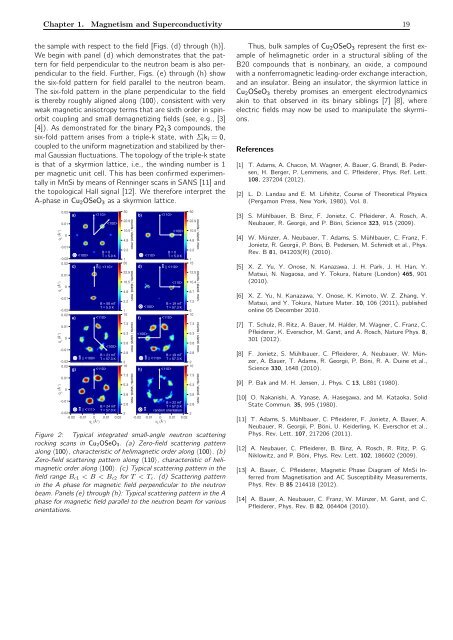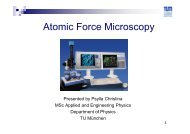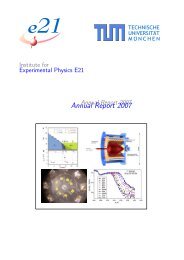Annual Report 2011 / 2012 - E21 - Technische Universität München
Annual Report 2011 / 2012 - E21 - Technische Universität München
Annual Report 2011 / 2012 - E21 - Technische Universität München
You also want an ePaper? Increase the reach of your titles
YUMPU automatically turns print PDFs into web optimized ePapers that Google loves.
counts / stand. mon. counts / stand. mon. counts / stand. mon. counts / stand. mon.<br />
counts / stand. mon. counts / stand. mon. counts / stand. mon. counts / stand. mon.<br />
Chapter 1. Magnetism and Superconductivity 19<br />
the sample with respect to the field [Figs. (d) through (h)].<br />
We begin with panel (d) which demonstrates that the pattern<br />
for field perpendicular to the neutron beam is also perpendicular<br />
to the field. Further, Figs. (e) through (h) show<br />
the six-fold pattern for field parallel to the neutron beam.<br />
The six-fold pattern in the plane perpendicular to the field<br />
is thereby roughly aligned along 〈100〉, consistent with very<br />
weak magnetic anisotropy terms that are sixth order in spinorbit<br />
coupling and small demagnetizing fields (see, e.g., [3]<br />
[4]). As demonstrated for the binary P2 1 3 compounds, the<br />
six-fold pattern arises from a triple-k state, with Σ i k i = 0,<br />
coupled to the uniform magnetization and stabilized by thermal<br />
Gaussian fluctuations. The topology of the triple-k state<br />
is that of a skyrmion lattice, i.e., the winding number is 1<br />
per magnetic unit cell. This has been confirmed experimentally<br />
in MnSi by means of Renninger scans in SANS [11] and<br />
the topological Hall signal [12]. We therefore interpret the<br />
A-phase in Cu 2 OSeO 3 as a skyrmion lattice.<br />
q y<br />
(Å -1 )<br />
q y<br />
(Å -1 )<br />
0.02<br />
0.01<br />
0<br />
-0.01<br />
0.01<br />
0<br />
-0.01<br />
a)<br />
ᐸ100ᐳ<br />
-0.02<br />
0.02<br />
c)<br />
-0.02<br />
0.02<br />
e)<br />
q y<br />
(Å -1 )<br />
q y<br />
(Å -1 )<br />
0.01<br />
0<br />
0.01<br />
0<br />
-0.01<br />
-0.02<br />
-0.02<br />
ᐸ110ᐳ<br />
ᐸ100ᐳ<br />
B = 0<br />
T = 5.0 K<br />
B || ᐸ110ᐳ<br />
B = 58 mT<br />
T = 5.0 K<br />
ᐸ110ᐳ<br />
ᐸ100ᐳ<br />
-0.01<br />
B = 21 mT<br />
B || ᐸ100ᐳ T = 57.3 K<br />
-0.02<br />
0.02<br />
g)<br />
ᐸ110ᐳ<br />
50<br />
22.9<br />
10.5<br />
4.8<br />
2.2<br />
1<br />
50<br />
22.9<br />
10.5<br />
4.8<br />
2.2<br />
1<br />
10<br />
7.3<br />
5.3<br />
3.8<br />
2.8<br />
2<br />
10<br />
7.3<br />
5.3<br />
3.8<br />
2.8<br />
B = 24 mT<br />
B || ᐸ111ᐳ T = 57.0 K<br />
2<br />
-0.01 0 0.01 0.02<br />
q x<br />
(Å -1 )<br />
b)<br />
d)<br />
f)<br />
ᐸ100ᐳ<br />
h)<br />
ᐸ110ᐳ<br />
ᐸ100ᐳ<br />
B || ᐸ110ᐳ<br />
ᐸ110ᐳ<br />
ᐸ100ᐳ<br />
B = 0<br />
T = 5.0 K<br />
B || ᐸ110ᐳ<br />
ᐸ110ᐳ<br />
B = 19 mT<br />
T = 57.3 K<br />
ᐸ110ᐳ<br />
B = 19 mT<br />
T = 57.3 K<br />
ᐸ110ᐳ<br />
50<br />
22.9<br />
10.5<br />
4.8<br />
2.2<br />
1<br />
15<br />
12.5<br />
10.4<br />
8.7<br />
7.2<br />
6<br />
10<br />
7.3<br />
5.3<br />
3.8<br />
2.8<br />
2<br />
10<br />
7.3<br />
5.3<br />
3.8<br />
B = 22 mT<br />
2.8<br />
T = 57.0 K<br />
B random orientation<br />
2<br />
-0.02 -0.01 0 0.01 0.02<br />
q x<br />
(Å -1 )<br />
Figure 2: Typical integrated small-angle neutron scattering<br />
rocking scans in Cu 2OSeO 3. (a) Zero-field scattering pattern<br />
along 〈100〉, characteristic of helimagnetic order along 〈100〉. (b)<br />
Zero-field scattering pattern along 〈110〉, characteristic of helimagnetic<br />
order along 〈100〉. (c) Typical scattering pattern in the<br />
field range B c1 < B < B c2 for T < T c. (d) Scattering pattern<br />
in the A phase for magnetic field perpendicular to the neutron<br />
beam. Panels (e) through (h): Typical scattering pattern in the A<br />
phase for magnetic field parallel to the neutron beam for various<br />
orientations.<br />
Thus, bulk samples of Cu 2 OSeO 3 represent the first example<br />
of helimagnetic order in a structural sibling of the<br />
B20 compounds that is nonbinary, an oxide, a compound<br />
with a nonferromagnetic leading-order exchange interaction,<br />
and an insulator. Being an insulator, the skyrmion lattice in<br />
Cu 2 OSeO 3 thereby promises an emergent electrodynamics<br />
akin to that observed in its binary siblings [7] [8], where<br />
electric fields may now be used to manipulate the skyrmions.<br />
References<br />
[1] T. Adams, A. Chacon, M. Wagner, A. Bauer, G. Brandl, B. Pedersen,<br />
H. Berger, P. Lemmens, and C. Pfleiderer, Phys. Ref. Lett.<br />
108, 237204 (<strong>2012</strong>).<br />
[2] L. D. Landau and E. M. Lifshitz, Course of Theoretical Physics<br />
(Pergamon Press, New York, 1980), Vol. 8.<br />
[3] S. Mühlbauer, B. Binz, F. Jonietz, C. Pfleiderer, A. Rosch, A.<br />
Neubauer, R. Georgii, and P. Böni, Science 323, 915 (2009).<br />
[4] W. Münzer, A. Neubauer, T. Adams, S. Mühlbauer, C. Franz, F.<br />
Jonietz, R. Georgii, P. Böni, B. Pedersen, M. Schmidt et al., Phys.<br />
Rev. B 81, 041203(R) (2010).<br />
[5] X. Z. Yu, Y. Onose, N. Kanazawa, J. H. Park, J. H. Han, Y.<br />
Matsui, N. Nagaosa, and Y. Tokura, Nature (London) 465, 901<br />
(2010).<br />
[6] X. Z. Yu, N. Kanazawa, Y. Onose, K. Kimoto, W. Z. Zhang, Y.<br />
Matsui, and Y. Tokura, Nature Mater. 10, 106 (<strong>2011</strong>), published<br />
online 05 December 2010.<br />
[7] T. Schulz, R. Ritz, A. Bauer, M. Halder, M. Wagner, C. Franz, C.<br />
Pfleiderer, K. Everschor, M. Garst, and A. Rosch, Nature Phys. 8,<br />
301 (<strong>2012</strong>).<br />
[8] F. Jonietz, S. Mühlbauer, C. Pfleiderer, A. Neubauer, W. Münzer,<br />
A. Bauer, T. Adams, R. Georgii, P. Böni, R. A. Duine et al.,<br />
Science 330, 1648 (2010).<br />
[9] P. Bak and M. H. Jensen, J. Phys. C 13, L881 (1980).<br />
[10] O. Nakanishi, A. Yanase, A. Hasegawa, and M. Kataoka, Solid<br />
State Commun. 35, 995 (1980).<br />
[11] T. Adams, S. Mühlbauer, C. Pfleiderer, F. Jonietz, A. Bauer, A.<br />
Neubauer, R. Georgii, P. Böni, U. Keiderling, K. Everschor et al.,<br />
Phys. Rev. Lett. 107, 217206 (<strong>2011</strong>).<br />
[12] A. Neubauer, C. Pfleiderer, B. Binz, A. Rosch, R. Ritz, P. G.<br />
Niklowitz, and P. Böni, Phys. Rev. Lett. 102, 186602 (2009).<br />
[13] A. Bauer, C. Pfleiderer, Magnetic Phase Diagram of MnSi Inferred<br />
from Magnetisation and AC Susceptibility Measurements,<br />
Phys. Rev. B 85 214418 (<strong>2012</strong>).<br />
[14] A. Bauer, A. Neubauer, C. Franz, W. Münzer, M. Garst, and C.<br />
Pfleiderer, Phys. Rev. B 82, 064404 (2010).




